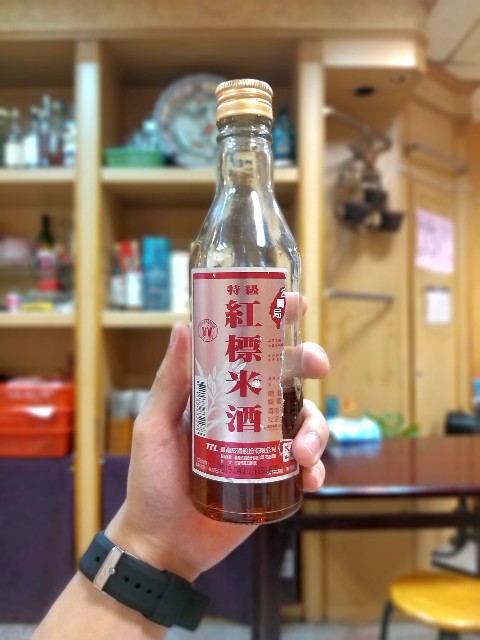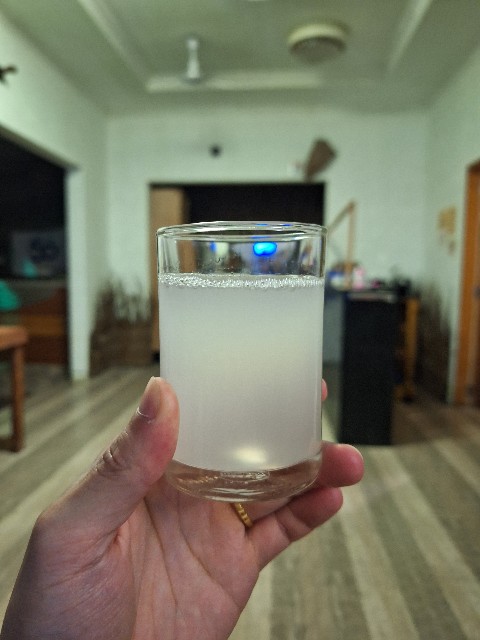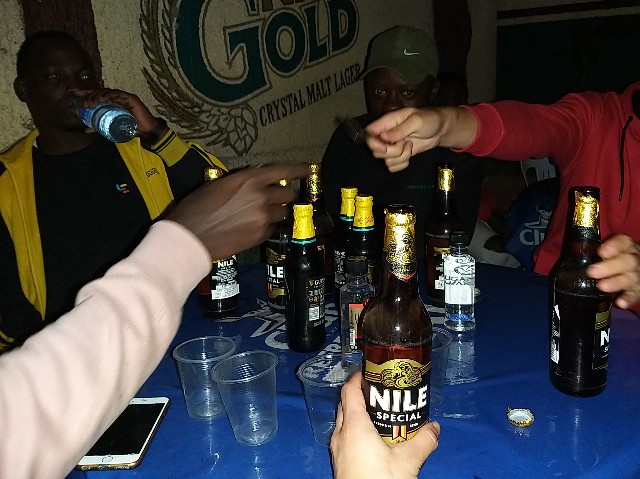A Summer in Taipei

I was on a whirlwind two-night, three-day foodie trip with my friends. On that particular day, we were savoring a slightly late breakfast of lu rou fan in the shade of the towering banyan tree at Dadaocheng Cisheng Temple. Enjoying lu rou fan under the fresh dappled sunlight in front of the Dadaocheng Cisheng Temple was exceptional, and combined with the local atmosphere of lined-up food stalls, it was the perfect location to satisfy our travel cravings. While pondering this and indulging in conversation with my companions, I noticed a group of local blue-collar men at a nearby table, mixing some peculiar alcohol.

A mysterious red liquid poured from unlabeled bottles. In the morning light, the men in work clothes were chatting away, sipping this red alcohol. Despite having visited Taiwan numerous times, this was my first encounter with this strange drink. The discovery of an unknown alcohol stirred my excitement. As a self-proclaimed mystery alcohol hunter who has pursued unknown “mystery drinks” from Ethiopia to Uganda around the world, I was instantly compelled to know the identity of this alcohol. Pushed by curiosity, I approached the men, intending to ask the name of this mysterious drink through gestures. However, the men looked at me suspiciously, showing an obvious rejection. Perhaps they mistook me for some suspicious person. Well, that’s understandable; being suddenly asked about the name of a drink by an unknown foreigner would be nothing but suspicious. While regretting that I had ultimately disrupted their morning enjoyment, I couldn’t give up. I decided to embark on a journey around Taipei to uncover the identity of this red mystery alcohol.
I immediately started searching for the mystery alcohol in shops around Taipei
I searched for the red mystery alcohol in convenience stores, supermarkets, and local shops. However, no matter how much I looked, I unfortunately couldn’t find the drink in question. Even if I had come across some kind of red alcohol, I had no way to verify if it was the same drink the men were drinking. Unable to find any clues, my two-night, three-day whirlwind trip came to an end, and I had to return to Japan temporarily.
As soon as I returned to Japan, I explored my next move
I contacted my Taiwanese acquaintances and posted in Taiwanese communities on social media with the photo, asking for “Information about the red mystery alcohol”, and waited for responses. Although the photo was blurry as it was taken from afar, I was confident that locals would provide some clues. However, my acquaintances replied, “I have no idea.” This was because the younger generation has different alcohol preferences from the older generation, and they had no knowledge of the kind of alcohol that 60-70 year old men would prefer to drink on the street. Meanwhile, reactions kept coming from the Taiwanese community on social media, but they were similarly clueless comments, or suggestions like “Could it be a mix of wine and shochu?” or “Maybe it’s wine diluted with water.” Wine mixed with shochu, or wine diluted with water… Indeed, it’s not impossible that the men might have filled bottles with wine themselves, mixing it with shochu or water to bring along. However, if it’s not an unknown alcohol but just an original wine cocktail, it’s a bit disappointing. Besides, would these men in work clothes be drinking something as sophisticated as wine on the street? Somehow, it didn’t add up. I decided to explore other possibilities.
After a while, an eye-catching comment came in
The topic I posted on social media, “What is the identity of the red mystery alcohol that working men in Taipei were drinking?” attracted some attention, and ended up involving dozens of local Taiwanese people, turning into something of a discussion forum. Amidst this, a comment from a local Taiwanese person changed the flow: “I know a red alcohol that the older generation in Taipei likes to drink.” According to her, it might be an alcohol called “Whisbih” sold in local pharmacies in Taiwan.
Whisbih is a popular medicinal alcohol in Taiwan. It was launched in 1974 by Sanyo Pharmaceutical Industry. It has an alcohol content of 6% and a reddish color.
Whisbih is mainly made from Chinese herbal medicines and malt extract. The Chinese herbs contain ingredients believed to be effective for fatigue recovery and nourishment. Therefore, in Taiwan, it is often drunk by manual laborers and drivers for fatigue recovery and energy replenishment.
Whisbih is not only drunk straight but also often combined with various beverages. Popular combinations include coconut juice, fruit juice, beer, rice wine, kaoliang liquor, coffee, oolong tea, and green tea. These combinations are known as “Gongdi Cocktails” in Taiwan and have become a staple drink in Taiwanese workplaces.
Whisbih commercials often feature Hong Kong actor Chow Yun-fat. Chow Yun-fat appeared in Whisbih commercials from 1987 to the 2000s, greatly increasing Whisbih’s recognition.
This must be it. The fact that it’s a red alcohol, and that it’s popular among manual laborers. All the characteristics perfectly match the red mystery alcohol I saw. Still, I hadn’t expected it to be a medicinal alcohol for nourishment. Is it similar to Yomeishu in Japan? No wonder the younger generation had no idea when asked about it.
I immediately packed my bags and secured another ticket to Taiwan to confirm the truth. As a mystery alcohol hunter, I couldn’t resist tasting Whisbih directly. By the way, as a side note, there’s a competing product to Whisbih called Paolyta-B, which is also a medicinal alcohol made from Chinese herbs and malt extract. It has an alcohol content of 5%, is brown in color, and while Whisbih is popular in northern Taiwan, Paolyta-B has a larger market share in the south.
I returned to Taiwan and finally got Whisbih at a drugstore

Although I couldn’t find a convenient size and only managed to get a large 600ml bottle, I finally encountered Whisbih at a local drugstore. Perhaps because it’s a medicinal alcohol, it seems to be classified similar to what we’d call “Class 2 Pharmaceutical Products” in Japan, and apparently it’s difficult to obtain in the market except at drugstores staffed by medical professionals. No wonder it wasn’t available in general stores or supermarkets.

The long-awaited red mystery alcohol. Let’s imitate the working men and drink it on the street in a park. Unfortunately, I don’t have a cup, so it’s a manly straight-from-the-bottle drink.

Hmm!! What is this taste?! It’s more exotic than I expected. I was prepared for some spicy flavor after hearing it was a medicinal alcohol, but the overpowering scent of Chinese herbs chemically reacted with the sweetness of the alcohol, creating an indescribable, exquisite taste. At first, you taste the sweet syrup and a subtle bitterness of tree bark, then gradually you start to sense a small amount of the unique taste of vitamin B (a bit like Lipovitan D) in your mouth. As a mystery alcohol hunter, I was overjoyed to encounter an unknown taste, but this certainly wouldn’t be popular with the general public. Perhaps if mixed with soda or cola, this intense flavor might mellow out to a more palatable taste. Still, it’s a powerful taste that seems likely to have a nourishing effect.
But here, a doubt suddenly crossed my mind
Were those working men that morning really drinking such an intense alcohol so casually? When I approached them to ask the name of the drink, I didn’t sense even a whiff of this powerful aroma. Perhaps what they were drinking wasn’t Whisbih at all.
I thought I had finally reached the truth in my quest for the mystery alcohol by obtaining Whisbih. However, after actually tasting Whisbih, I intuitively understood that the mystery alcohol I saw that day was different from Whisbih. At this point, I had lost all my leads and was back to square one. Holding the large bottle of Whisbih, I stood there dumbfounded for a while.
That night, I had a solo reflection session at Guangzhou Street Tourist Night Market

Having lost my leads in the search for the mystery alcohol and finding myself back at the starting point, I decided to have a solo reflection session while eating at a food stall to strategize my next move. In the midst of this, I had a miraculous encounter.

Amazingly, at a stall I happened to pass by, bottles filled with red alcohol were displayed. Moreover, the shape of the bottles and the labels perfectly matched what the working men had that day. This must be the identity of the mystery alcohol!

I immediately bought a bottle and poured it into a cup. This red color looks familiar. There’s no doubt it’s that mystery alcohol. The reflection session turned into a celebratory evening drink with the mystery alcohol. The lu rou fan I got from the nameless food stall also tasted exceptionally good, perhaps seasoned with a sense of accomplishment.

At last, the identity of the red mystery alcohol is revealed

Now, the red mystery alcohol I finally encountered at the food stall turned out to be a rice wine called “Hong Biao Mi Jiu” (Red Label Rice Wine). Hong Biao Mi Jiu is known as one of the most famous rice wine brands in Taiwan, launched in 1953 by the Taiwan Tobacco and Liquor Corporation. It has an alcohol content of 19.5 degrees, and comes in both clear and red colors (sometimes affectionately called “Hong Biao” and “Bai Biao” respectively). It’s mainly made from rice, fermented with rice koji and yeast, and then distilled. The taste is somewhat close to Japanese sake, rich in rice flavor and aroma, with a characteristic smooth mouthfeel.

Hong Biao Mi Jiu is not only drunk straight but is also popular mixed with beer. Besides being consumed as a beverage, it’s often used as a seasoning in Taiwanese cuisine, particularly effective in removing the smell from meat and fish or adding depth of flavor. In fact, when I later searched again in a supermarket, I successfully found it not in the alcohol section, but in the seasoning section.
The world’s mystery alcohols are interesting
Well, this time we’ve introduced Taiwan’s red mystery alcohol “Hong Biao Mi Jiu”, and incidentally, a strong-flavored mystery alcohol called “Whisbih”. The mystery alcohols you encounter overseas are full of surprises, romance, and thrills, with flavors, textures, and mouthfeels that you can’t experience in Japan. This blog has introduced mystery alcohols from around the world before, so if you like unusual global cuisine, please bookmark it. I intend to further advance my activities as a mystery alcohol hunter to continue sharing the charm of mystery alcohol with all of you.



![Mysterious Ethiopian Liquor: Drink “Tella” at a Local Pub! [Ethiopia Travel Journal]](https://en.kosupatravel.com/wp-content/uploads/2022/07/20220728123957.jpg)

